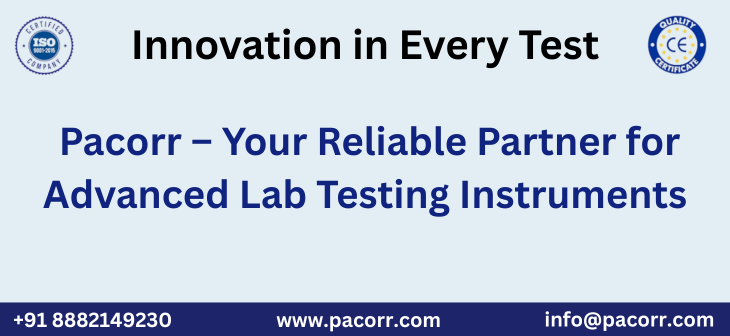
Pacorr is a recognized leader in the field of quality testing instruments, known for manufacturing advanced and reliable vibration testing machines designed to simulate real-world conditions for packaging, automotive, and electronics industries. As industries push the boundaries of product resilience, vibration tables have become a vital tool in modern quality control labs. However, operating these machines requires strict adherence to safety standards to prevent injuries, equipment damage, and test inconsistencies. This article outlines essential safety precautions while operating a vibration table, offering both experienced professionals and first-time users a comprehensive guide rooted in best practices.
Understanding the Function of a Vibration Table
Before diving into safety procedures, it is important to understand what a vibration table is and why it plays a critical role in the testing environment. A vibration testing table, also known as a vibration tester, replicates the vibrational forces that products endure during transportation, handling, or usage. These forces can affect packaging integrity, electronic component reliability, and structural durability. Pacorr’s vibration testing equipment is specifically engineered to deliver accurate and repeatable testing conditions, but without following proper safety protocols, even the most sophisticated equipment can pose significant hazards.
Importance of Safety in Vibration Testing
Operating a vibration testing machine involves moving platforms, electrical systems, and high-frequency oscillations. These dynamic elements require a controlled and vigilant approach to prevent operational disruptions and workplace accidents. Safety in this context is not only about personal protection but also about preserving the accuracy of test results and prolonging the life of the machine. Proper training, machine handling, and routine maintenance are central to ensuring both human and equipment safety.
Pre-Operational Safety Measures
Before initiating any vibration test, it is vital to establish a safety-first mindset and perform thorough pre-checks. These preliminary steps form the foundation for safe operation.
Inspect the Machine Thoroughly
Ensure the vibration table is clean, stable, and free from any mechanical issues. Check for visible signs of wear, loose fasteners, or cracks in the platform. A physical inspection can reveal early signs of damage that may become serious hazards during operation.
Verify Electrical Connections
All vibration testing machines operate using electrical power. Make sure all connections are secure, grounded properly, and free of frayed wires. Avoid using extension cords or makeshift electrical setups that can lead to short circuits or shocks.
Calibrate the Machine Correctly
Calibration is not just a quality step but also a safety requirement. A miscalibrated vibration table may operate outside its design parameters, causing mechanical failures or inaccurate results. Follow standard calibration procedures to align frequency and amplitude settings with the test specifications.
Use Appropriate Fixtures and Fasteners
Every test sample must be mounted securely using manufacturer-approved clamps or fasteners. Never use makeshift mounting systems, as loose parts can become projectiles at high frequencies. Pacorr recommends using compatible accessories specifically designed for their vibration testing equipment to ensure secure and stable sample positioning.
Operator Safety Practices During Testing
Once the pre-checks are complete, safety becomes a matter of awareness and discipline during the test cycle. The following practices ensure smooth and hazard-free operations.
Keep a Safe Distance
During the test, no part of the operator’s body should come into contact with the platform. Even minor contact during high-frequency movement can lead to injury. Maintain a safe operational perimeter around the vibration table and install protective barriers if required.
Do Not Leave the Machine Unattended
Although modern vibration testing machines from Pacorr are equipped with automated control systems, it is unsafe to leave the equipment running without supervision. An unexpected mechanical fault, power surge, or sample failure can create dangerous conditions that need immediate response.
Monitor Sound and Vibration Anomalies
Any unusual sound, irregular vibration pattern, or excessive noise during operation is a sign of potential failure. Stop the test immediately, inspect the machine, and troubleshoot before resuming.
Wear Personal Protective Equipment (PPE)
Operators should always wear appropriate PPE including safety goggles, industrial gloves, and non-slip footwear. Depending on the intensity of the test, ear protection may also be required to shield from high decibel noise levels.
Follow Emergency Stop Protocols
Ensure every operator knows the location and use of the emergency stop mechanism. In case of any irregularity or danger, the machine must be shut down immediately. Pacorr designs its vibration testing tables with accessible emergency shut-off features to promote workplace safety.
Post-Operation Safety Measures
Completing a test does not mark the end of safety responsibility. Several steps must be taken to safely conclude the test and prepare the machine for future use.
Power Down Properly
Turn off the vibration tester using the recommended shutdown procedure. Avoid cutting power abruptly unless in an emergency. Controlled power-down minimizes wear on internal components.
Inspect for Damage
After each session, inspect the machine and test specimen for signs of wear or damage. Pay close attention to mounting brackets, electrical cords, and the platform surface. Document any issues to prevent recurrence.
Clean and Store Equipment
Remove debris or sample residue from the platform. Clean the vibration testing equipment using a dry cloth or vacuum. Avoid using water or solvents that can seep into electrical components.
Log Test Data and Machine Usage
Maintain a usage log that includes operator name, test conditions, and any anomalies observed. This record improves traceability and supports preventive maintenance programs.
Additional Guidelines for Long-Term Safety
Beyond day-to-day precautions, adopting broader safety policies helps establish a culture of accountability and professionalism in the testing lab.
Implement Training Programs
Every operator should undergo regular training on machine operation, troubleshooting, and safety. Refresher sessions help reinforce protocols and introduce updates in equipment handling.
Schedule Preventive Maintenance
Routine maintenance extends machine life and ensures test integrity. Replace worn-out parts, lubricate moving components, and test emergency shut-off systems periodically.
Limit Access to Authorized Personnel Only
Restrict the use of vibration testing machines to trained personnel. Unauthorized access increases the risk of improper use and accidents.
Update Safety Documentation
Ensure that all operation manuals, risk assessments, and emergency procedures are up-to-date and accessible to everyone in the testing environment.
The Pacorr Commitment to Safety
What sets Pacorr’s vibration testing equipment apart is not just advanced engineering, but also a thoughtful design approach that prioritizes operator safety. From shock-absorbing mounts to automated fail-safe controls, every Pacorr vibration tester is built to operate with maximum efficiency and minimum risk. Organizations across industries rely on these systems not only for their accuracy but also for their compliance with global safety standards.
By integrating intuitive controls, high-durability construction, and precision mechanics, Pacorr enables professionals to conduct vibration testing with confidence. Safety is not an afterthought—it is embedded into the design philosophy of every machine.
Conclusion
In any high-performance testing environment, safety must be treated with the same level of importance as precision. Operating a vibration table without adhering to standard safety precautions can result in injuries, damage to valuable equipment, and unreliable test data. By following a structured approach to inspection, operation, and post-test handling, companies can ensure that every use of a vibration testing machine is both productive and safe.
Pacorr continues to lead the way by delivering equipment that balances performance with protection, empowering industries to maintain quality while safeguarding their teams. When used responsibly and maintained properly, vibration tables can significantly enhance product development and reliability testing with complete peace of mind.
Thanks to Pacorr Testing instruments, we have all the required quality testing instruments that have helped us to ensure the best quality delivered to our clients.

Danish
Fair Exports Pvt. Ltd.

